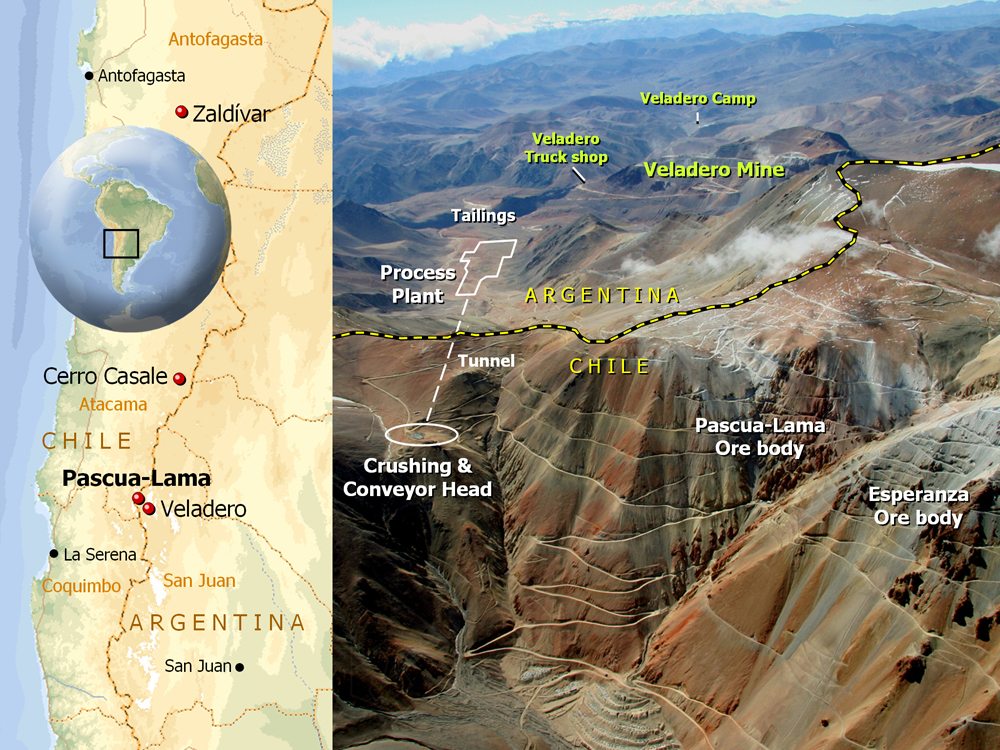SPECIAL REPORT ON PASCUA-LAMA: Part 1 – The promise of a better future


High in the barren Andes Mountains lies a body of ore spanning the border between Chile and Argentina. Known as Pascua-Lama, it is believed to be the world’s first bi-national gold mining project.
At the site of the project and in Barrick’s offices on both sides of the border, years of planning and preparation have translated into intense activity. A major hiring campaign is underway and initial construction has begun.
Anticipation is high among job-seekers living in the rural valleys closest to the project area and in towns over a 100 km away in Argentina's San Juan province Argentina and Chile’s Atacama region. During the project’s three-year construction phase, more than 5,500 direct jobs will be created. Priority will be given to hiring local people, a welcome feature of the project given current high levels of unemployment. Once in production, Pascua-Lama will employ approximately 1,600 people. For each direct job created, an estimated 2.5 to 3.0 indirect jobs are expected to be generated.
Scarlett Jara is Pascua-Lama’s recruitment and training manager and she leads a team responsible for staffing the project. She spends most of her days in back-to-back interviews. To date, the company has received 145,000 job applications and more continue to flood in daily. That is roughly equivalent to the populations of Greenland and Bermuda combined.
A special computerized data management system was installed to sort and categorize the huge volume of interested candidates. "There is an enormous sense of momentum now that the hiring process is well underway," reports Jara. "Given the urgent need for employment in the region, it is a real pleasure to be able to offer people quality jobs with such a great company."
Budding entrepreneurs hoping to sell their goods and services are also gearing up to support the project. Recent company information sessions have attracted more than 800 potential suppliers and many are being evaluated by the company. This is in addition to the hundreds of contractors who have helped to move the project forward over the years.
Evidence that Pascua-Lama will have a powerful, far-reaching economic stimulus effect can be found only 10 km away at neighbouring Veladero mine in Argentina. Now four years into operation, Veladero has become a catalyst for economic development and an important source of investment to the San Juan provincial economy. Pascua-Lama is among Barrick’s next generation of larger, lower cost mines that include the Cortez Hills project in Nevada and the Pueblo Viejo project in the Dominican Republic. Pre-production construction costs for Pascua-Lama are estimated at between $2.8 billion to $3 billion, and significant tax revenues and royalties will be generated during the expected 25-year mine life. The large capital investment up front will build one of the lowest cost gold producing mines in the world, with anticipated total cash costs at $20-$50 per ounce.
Such a significant investment, combined with the company’s community programs, will help regions struggling to modernize and achieve socio-economic development. Argentina and Chile are middle-income countries and offer a highly attractive investment climate for companies like Barrick. Yet like so many countries, the ability to identify pathways out of poverty for disadvantaged citizens has proven challenging.
On the Chilean side of the project, the Atacama Region is home to many remote agrarian communities. It is also an area rich in untapped resources, with vast tracts of dry, inhospitable land that cannot support farming. Pockets of poverty exist, where hundreds of families struggle to subsist and meet their basic daily needs. Nationally, the Atacama region has one of the highest proportions of families living in substandard housing, known as "campamentos." The latest regional figures put unemployment at 11.6%. In the more densely populated city of Vallenar, the jobless rate is 14%. Many people with deep ties to the area have had to leave to find employment. In this region, the mining sector has been an important job creator. Currently, it is one of the area’s largest employers, providing jobs for nearly 16,000 people in 2008.
Well-planned, well-run mines can improve quality of life in the communities around them. Pascua-Lama is a case in point. To maximize its potential benefits for communities in the region and in San Juan province, from 2005 to 2008, Barrick implemented a vast, bi-national training program in preparation for project go-ahead. The aim was to build the capacity and increase the local skills base to create employment and other opportunities.
Close to 10,000 people have benefited from these wide-ranging training programs, which have included a supplier development program, technical, industrial and farming skills, and teacher training. Barrick has long recognized the relationship between education levels and development. Some 700 local students have received scholarships to pursue a higher education in fields that included but were not limited to mining. Similar sustainable development projects are underway or being planned for San Juan province.
Next, the journey to development.
Comments